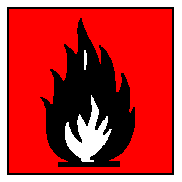International Chemical Safety Cards
| ALUMINIUM PHOSPHIDE | ICSC: 0472 |
| ALUMINIUM PHOSPHIDE Aluminum phosphide AlP Molecular mass: 58 CAS # 20859-73-8 RTECS # BD1400000 ICSC # 0472 UN # 1397 EC # 015-004-00-8 |
 |
 |
| TYPES OF HAZARD/ EXPOSURE |
ACUTE HAZARDS/ SYMPTOMS |
PREVENTION | FIRST AID/ FIRE FIGHTING |
| FIRE | Not combustible but forms
flammable gas on contact with water or damp air. Gives off irritating or toxic fumes (or
gases) in a fire. |
NO open flames, NO sparks,
and NO smoking. NO contact with acid(s) and water. |
Special powder, dry sand,
NO other agents. NO water. |
| EXPLOSION | Risk of fire and explosion
on contact with acid(s) and water. |
|
|
| EXPOSURE | |
PREVENT DISPERSION OF DUST!
STRICT HYGIENE! |
|
| INHALATION | Sore throat. Cough.
Shortness of breath. Headache. Dizziness. Nausea. Vomiting. |
Local exhaust or breathing
protection. |
Fresh air, rest.
Half-upright position. Artificial respiration if indicated. Refer for medical attention. |
| SKIN | Redness. Burning
sensation. |
Protective gloves. |
Remove contaminated
clothes. Rinse and then wash skin with water and soap. Wear protective gloves when
administering first aid. |
| EYES | Redness. |
Safety goggles, or eye
protection in combination with breathing protection. |
First rinse with plenty of
water for several minutes (remove contact lenses if easily possible), then take to a
doctor. |
| INGESTION | Nausea. Vomiting.
Diarrhoea. Abdominal pain. Headache. Convulsions. Shock or collapse. Unconsciousness.
|
Do not eat, drink, or smoke
during work. Wash hands before eating. |
Induce vomiting (ONLY IN
CONSCIOUS PERSONS!). Refer for medical attention. |
| SPILLAGE DISPOSAL | STORAGE | PACKAGING & LABELLING | ||
| Evacuate danger area!
Consult an expert! Do NOT wash away into sewer. Sweep spilled substance into sealable
containers. Carefully collect remainder, then remove to safe place. Do NOT let this
chemical enter the environment (extra personal protection: complete protective clothing
including self-contained breathing apparatus). |
Fireproof. Provision to
contain effluent from fire extinguishing. Separated from acids, water, food and
feedstuffs. Dry. |
Airtight. Do not transport
with food and feedstuffs. F symbol T+ symbol R: 15/29-28 S: (1/2-)3/9/14-30-36/37-45 UN Hazard Class: 4.3 UN Subsidiary Risks: 6.1 UN Packing Group: I |
||
| SEE IMPORTANT INFORMATION ON BACK | ||||
|
||||